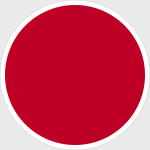DeAgostini DAWF01 Imperial Japanese Navy Kawanishi N1K2-J Shiden-kai "George" Fighter - Lt. Naoshi Kanno, 343 Kokutai, 304 Hikotai "Shinsen-Gumi," 1945 (1:72 Scale)
"We have resolved to endure the unendurable and suffer what is insufferable."
- Japanese Emperor Hirohito speaking to the Japanese people after the atomic bombings, August 1945
 The Kawanishi Shiden-Kai ("Violet Lightning") was one of the best fighters produced for the Japanese Navy during WWII, essentially a ground-based variant of the Kawanishi N1K1 Kyofu "Rex" seaplane. The N1K2-J and its predecessor, the N1K1-J, derived from Kawanishi N1K1 seaplane fighter (code name "Rex"), arose from a development ordered by the Imperial Navy in 1940. On its own initiative, however, Kawanishi modified the seaplane design by turning it into a land-based plane, which it later called "George."
The Kawanishi Shiden-Kai ("Violet Lightning") was one of the best fighters produced for the Japanese Navy during WWII, essentially a ground-based variant of the Kawanishi N1K1 Kyofu "Rex" seaplane. The N1K2-J and its predecessor, the N1K1-J, derived from Kawanishi N1K1 seaplane fighter (code name "Rex"), arose from a development ordered by the Imperial Navy in 1940. On its own initiative, however, Kawanishi modified the seaplane design by turning it into a land-based plane, which it later called "George."
After several successful tests, it offered the experimental model to the Navy for further testing, but was greeted with skepticism, no doubt due to the success of the Zero. Not officially accepted by the Navy until 1943 and put into production after a series of modifications to its engine and landing gear, its entry into front line service was further delayed by difficulties in pilot training and logistical problems, reflecting Japan's military and economic reverses. Once operational, the George proved itself to be a superb aircraft which was respected by Allied pilots.
Pictured here is a 1:72 scale replica of an Imperial Japanese Navy Kawanishi N1K2-J Shiden-kai "George" fighter that was piloted by Lt. Naoshi Kanno, who was attached to the 343 Kokutai, 304 Hikotai "Shinsen-Gumi," during 1945.
Sold Out!
Dimensions:
Wingspan: 6-1/2-inches
Length: 5-inches
Release Date: February 2020
Historical Account: "Of Victory and Might" - By 1944, the Japanese Imperial Navy Air Force was weakened, but not quite defeated. In the midst of the gloom, one squadron began to shine brightly-the 343rd Air Group. This squadron of aces was masterminded by Capt. Minoru Genda, who was the man behind the successful attack on Pearl Harbor. Genda had himself transferred out of the Naval General Staff to command this elite unit. The 343rd AG was a hand-picked group of Japan's experienced pilots and was created to turn the tide of the air war over Japan. Genda's plan for winning was simple: first, he would use the best airplane available at that time, the Kawanishi Shiden Kai (Allied code name, "George"). Second, he would call on Japan's most experienced pilots to fly it. Among the pilots that flew with the unit were Lt. Naoshi Kanno (48 kills), Chief Petty Officer (CPO) Shoichi Sugita (120-- plus kills) and Ensign Kaneyoshi Muto (35 kills).
Genda also believed in the value of accurate reconnaissance data; for this, he relied on the 4th Reconnaissance Squadron, which flew with a high-speed Carrier observation plane called the Saiun, or "iridescent cloud." Genda theorized that success in the air would be achieved by the improvement of air-to-air communications and formation combat, so he stressed the importance of this to his men; in fact, the 343rd AG was the only unit to have fighters with properly working radios! The Yokosuka AG had discovered that the simple modification of adding resistors to the spark-- plug wires made the Shiden Kai's Type 3 radio function perfectly. After hearing this, Genda ordered his entire unit to be retrofitted to improve air-to-air communications.
Last, Genda employed a couple of simple, yet efficient, psychological tools to boost the men's morale. To inspire his men, he posted banners in the front of the 343rd AG barracks. Also, he gave each squadron a popular name.
The 343rd AG consisted of five squadrons: 401st, 301st, 407th, 701st and the 4th Reconnaissance Squadron. The 301st became the Shinsen-gumi, or "elite guard"; the 407th was called Tenchugumi or "heavenly punishment unit"; the 701st Ishin-tai was the "imperial restoration unit"; and the 4th Reconnaissance Squadron, the Kiheitai, or "commando unit." It is not known whether the 401st Squadron, which was a training squadron, had a special name, but it did have the largest number of late-term flight-school pilots.
Veteran pilot Lt. Naoshi Kanno commanded the 301st Squadron, which suffered the greatest number of casualties of all five squadrons. Well-known Japanese ace Saburo Sakai reportedly said that Kanno was a bad leader because he was much too reckless in combat, hence, his unit had the most losses. On the other hand, Lt. Takashi Oshibuchi's squadron, the 701st, suffered the fewest casualties.





![RAF Panavia Tornado GR4 Fighter Bomber - ZA412, No.617 Squadron, 'Dambusters 70th Anniversary' [Anniversary Scheme] (1:72 Scale)](http://cdn4.volusion.store/qh9e9-jdqv9/v/vspfiles/photos/AA33614-1.jpg?v-cache=1740197136)

![Star Trek Eymorg Starship [With Collector Magazine]](http://cdn4.volusion.store/qh9e9-jdqv9/v/vspfiles/photos/EMST0127-1.jpg?v-cache=1740197136)
